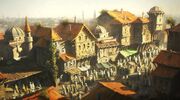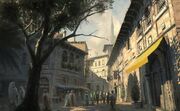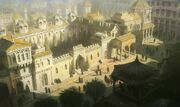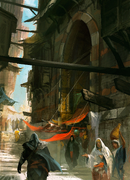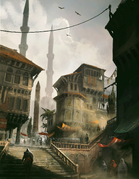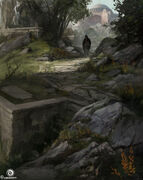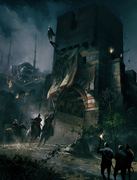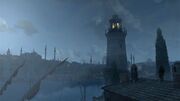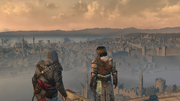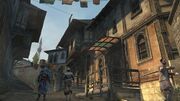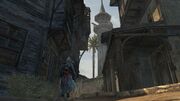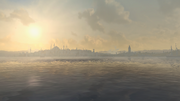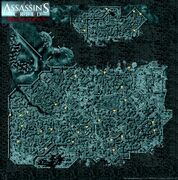- "The crossroads of the world. Many generations of men have ruled this city, but they have never subdued her. She always bounces back."
- ―Yusuf Tazim regarding Constantinople, 1511.[src]
Constantinople (Byzantine Greek: Konstantinoupolis; Latin: Constantinopolis or Byzantium; Turkish: Kostantiniyye or İstanbul), presently known as Istanbul, was the capital of the Byzantine Empire and, following the city's conquest in 1453, became the Ottoman Empire's capital in 1458.
The only major transcontinental city in the world, during the Renaissance, it was Europe's largest and wealthiest city, consisting of four distinct districts: Constantine, Bayezid, Imperial, and Galata.
History
Origins
The city began in 658 BC as Byzantium, a modest city-state situated on First Hill. It was founded by Byzas, a devout soldier who had chosen the location based on a promising prophecy uttered by the Oracle of Apollo at Delphi.[1]
Reportedly a rowdy port town, Byzantium was nevertheless considered an "island" of Hellenic civilization due to the many barbarian tribes that surrounded it. As time went on, both the city's inhabitants and its rulers diversified, with Spartans, Macedonians, Athenians, and Romans all having controlled Byzantium at one point.[1]
Byzantine Empire
In 324 CE, the Roman Emperor Constantine I, supposedly inspired by a vision from God, moved the capital of the Roman Empire to Byzantium, which he then rebuilt and expanded. When construction was finished in 330 CE, he had the city rechristened Nova Roma Constantinopolitana, or "New Rome, City of Constantine". Colloquially, it came to be known as both "Constantinopolis" and "New Rome", as the rulers still considered themselves Romans living in the Eastern Roman Empire.[1]
For the next 900 years, Constantinople served as the capital of the Eastern Roman Empire, as well as a beacon of Christianity, while the West experienced barbarian attacks and economic hardship.[1] Nevertheless, the city suffered its share of turmoil as well; in 1204, mass riots against the Emperor occurred, following which French and Venetian Crusaders invaded and sacked Constantinople. As a result, Altaïr Ibn-La'Ahad, Mentor of the Levantine Assassins, could not carry out his intentions of introducing the Assassin Brotherhood to the city and was forced to retreat.[2]
Captured by the invaders, Constantinople became part of the Latin Empire, leading to an influx of Venetian and Genoese merchants that settled on the south and north side of the Golden Horn respectively. In 1258, an Assassins' guild was established in the city by Niccolò and Maffeo Polo, who had come from the Assassin fortress of Masyaf. They also hid the five Masyaf Keys given to them by Altaïr in the Yerebatan Cistern, the Maiden's Tower, beneath the Forum of the Ox, Galata Tower and what would become Topkapı Palace.[1]
In 1261, Michael VIII Palaiologos, Greek heir to the Byzantine throne, marched on Constantinople and, after a decisive victory, managed to reclaim it. Yet, the recaptured city was struggling to survive; the Empire possessed but a mere fraction of its former land and power. Although Constantinople still flourished culturally, its population rapidly dwindled, leaving it an easy target for the continually expanding Ottoman Empire. The Byzantine Emperors attempted to get help from leaders in Western Europe, but ongoing wars and the complicated feelings held by the Catholic west concerning their Orthodox cousins led only to a series of half-hearted gestures and weak alliances.[1]
Ottoman Empire
In 1453, Constantinople was besieged by Sultan Mehmet II and his army. Although Byzantine Emperor Constantine XI Palaiologos managed to hold the city for 54 days, he and his forces were eventually defeated by the attackers, thanks to the Apple of Eden in Mehmet's possession.[3] Once Constantinople had officially come under Ottoman control, the Turks made it their priority to restore the city to its former glory, with the Sultans being tolerant of different religions. As a result, Constantinople became attractive to all kinds of people, causing the population to grow once more. It was also around this period that the city began to be called Istanbul by many of its residents.[1]
During the Renaissance, at some point between 1501 and 1507, the Doge of Venice, along with Sultan Bayezid II, sought to ally their considerable naval powers through a free trade treaty. However, the Templars were wary of any peace between the two, and became intent on interfering with their alliance. The Borgia family dispatched a force of mercenaries to disrupt the agreement, but they were quickly intercepted by members of the Italian Brotherhood of Assassins, who set their ship aflame before they could depart.[4][5]
By 1509, the Templars had began to relocate themselves to Constantinople due to their defeat in Italy and the disruption of their activities throughout Western Europe. The Templars formed a faction known as the Stewards of Byzantium and attempted to seize control of the city in the wake of Bayezid's absence, due to his civil war with his son Selim.[1]
During this year, an earthquake uncovered one of the Masyaf Keys hidden beneath Topkapı Palace. Two years later, after traveling to Masyaf to research his Assassin heritage, Ezio Auditore da Firenze, Mentor of the Italian Assassins, arrived in Constantinople to retrieve the other Keys before the Templars. His leadership enabled the Assassins to reclaim their dens from the Byzantines and liberated most of the shops from their control, much as he had in Rome, as well as training several Assassins to the rank of Master Assassin through the assassination of key Templar agents. However, when Selim took control of the throne, he banished Ezio from Constantinople,[1] though allowed him one final visit to the city to sort out his affairs, by request of his son Suleiman.[6]
Trivia
- Bernardo Baroncelli, one of the Pazzi conspirators, fled to Constantinople following the failed attempt to take over Florence.
- In Assassin's Creed: Revelations, the city was slightly smaller than Rome was in Assassin's Creed: Brotherhood, but it had more buildings, and was more densely populated.
- Alexandre Amancio, the Creative Director of the Assassin's Creed series, stated at E3 that Constantinople is a "really cool metaphor for Ezio meeting Altaïr", citing the fact that half of Constantinople was in Europe, and the other in Asia.
- It was also stated by Darby McDevitt that Constantinople would be a meaningful meeting of Ezio and Altaïr as the city itself was formerly under Christian control, then Muslim, which suited Altaïr and Ezio as the former hailed from a Muslim culture in Syria and the latter hailed from a Christian Italy.
- Constantinople was originally meant to be included in Assassin's Creed. [citation needed]
- In Assassin's Creed: Revelations, it is only possible to explore the section of the city within the Wall of Constantine and Galata, despite the fact that the Wall of Constantine had been superseded by the Theodosian Walls almost a thousand years beforehand and little remained of it. The rest of the city, which is wholly inaccessible, can be seen from high locations such as top of the Galata Tower and the minarets of the Fatih Camii.
Gallery
References










